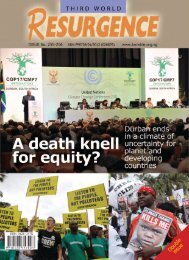Plantations, poverty and power - Critical Information Collective
Plantations, poverty and power - Critical Information Collective
Plantations, poverty and power - Critical Information Collective
You also want an ePaper? Increase the reach of your titles
YUMPU automatically turns print PDFs into web optimized ePapers that Google loves.
51<br />
company owners want profits to be realised. For example, a plantation company might sell wood fibre to<br />
a related pulp mill at a highly inflated cost, in order to transfer profits from the pulp mill (which may<br />
have, say, run up enormous debts which creditors are trying to reclaim by seizing the company’s profits)<br />
to the plantation company, which formally at least is a separate company. If the pulp mill meanwhile<br />
pours money in the form of interest-free loans into the plantation company this will also help hide the<br />
profits.<br />
CIFOR’s researchers, Romain Pirard <strong>and</strong> Rofikoh Rokhim, note that the prices of wood supply to APP’s<br />
pulp mills increased in a “spectacular way” from 2001 onwards. APP explains that this is because the<br />
company is increasingly using plantation wood, which is more expensive than clearcutting natural forests.<br />
Pirard <strong>and</strong> Rokhim point out that the mills have transferred tens of millions of dollars to the wood<br />
suppliers in recent years <strong>and</strong> that a more convincing reason for the wood price hike is the fact that during<br />
the 1990s APP attracted investors by advertising the company’s access to very cheap raw materials from<br />
native forests. After 2001, the agreements were changed: presumably so that the profits were transferred<br />
from the pulp mills to the wood supplier companies. Although the wood supplier companies are also<br />
controlled by the Widjaja family, they do not owe vast amounts of money to international investors. 246<br />
The banks lending to the Widjaja family companies in the 1990s made little effort to investigate the<br />
nature of the companies they were investing in. “When we approved the credit for millions of US dollars,<br />
we just signed <strong>and</strong> never asked in detail about the risks of the business”, a former director of corporate<br />
finance of a major financial institute told CIFOR’s researchers in an off-the-record interview in 2004. 247<br />
The banks allowed APP to run up colossal debts, totalling an estimated US$13.9 billion. Even after the<br />
Asian economic crisis, investors remained optimistic. “Asia Pulp & Paper: Here Comes the Cash Flow!”<br />
exclaimed Morgan Stanley in November 1999. 248 When it became clear that APP was having difficulty<br />
repaying its debts, investors continued to pour money into Widjaja family companies, including in the<br />
pulp <strong>and</strong> paper sector, in the hope that some of the new debt would be used to repay existing debts. 249<br />
Part of APP’s expansion was financed by Bank Internasional Indonesia, which is also part of the Sinar<br />
Mas Group. In 1999, the bank ran into difficulties because of its non-performing loans. The amount of<br />
loans that the bank gave to related parties was higher than allowed under Indonesian law. The case was<br />
never brought to court <strong>and</strong> the Indonesian Bank Restructuring Agency (IBRA) took over the bank’s nonperforming<br />
loans on behalf of the Government of Indonesia. IBRA ended up with US$1.3 billion of<br />
APP’s debts. 250 Ultimately, Indonesia’s taxpayers have ended up bailing out APP. In November 2001, the<br />
246 Romain Pirard <strong>and</strong> Rofikoh Rokhim (2006) “Asia Pulp & Paper Indonesia: The business rationale that led to forest<br />
degradation <strong>and</strong> financial collapse ”, CIFOR, Working Paper No. 33, page 9.<br />
http://www.robinwood.de/german/trowa/sumatra/appcifor2006.pdf<br />
247 Romain Pirard <strong>and</strong> Rofikoh Rokhim (2006) “Asia Pulp & Paper Indonesia: The business rationale that led to forest<br />
degradation <strong>and</strong> financial collapse ”, CIFOR, Working Paper No. 33, page 4.<br />
http://www.robinwood.de/german/trowa/sumatra/appcifor2006.pdf<br />
248 Romain Pirard <strong>and</strong> Rofikoh Rokhim (2006) “Asia Pulp & Paper Indonesia: The business rationale that led to forest<br />
degradation <strong>and</strong> financial collapse ”, CIFOR, Working Paper No. 33, page 5.<br />
http://www.robinwood.de/german/trowa/sumatra/appcifor2006.pdf<br />
249 Romain Pirard <strong>and</strong> Rofikoh Rokhim (2006) “Asia Pulp & Paper Indonesia: The business rationale that led to forest<br />
degradation <strong>and</strong> financial collapse ”, CIFOR, Working Paper No. 33, page 5.<br />
http://www.robinwood.de/german/trowa/sumatra/appcifor2006.pdf<br />
250 Romain Pirard <strong>and</strong> Rofikoh Rokhim (2006) “Asia Pulp & Paper Indonesia: The business rationale that led to forest<br />
degradation <strong>and</strong> financial collapse ”, CIFOR, Working Paper No. 33, page 5.















